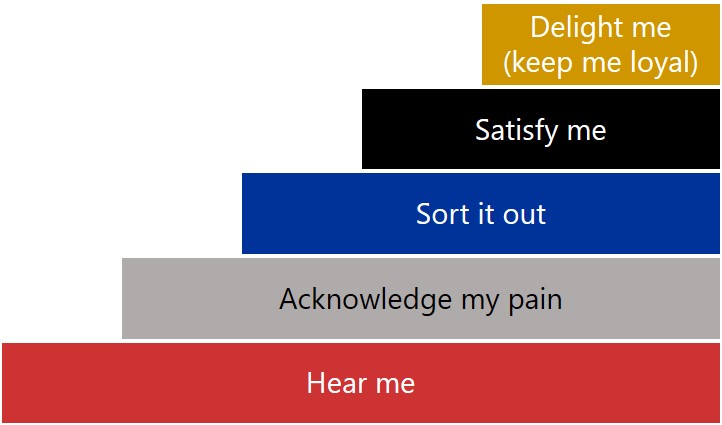Unpacking the way in which my complaint to the AA was handled shows how a more customer-centric approach would have helped.
My recent experience with the AA resulted in a complaint which resulted in me leaving the AA, only to return as part of a much better deal with my car insurance provider. My original experience was bad but the complaints handling was not great either. However, as with all bad experiences, there is much that we can learn – in this case how to handle complaints so that they add value to the organisation and the customer.
My experience and observation of the complaint leads me to highlight five do’s and don’ts that, if followed, will turn your complaints department into a source of value for your organisation.
1. Don’t hide behind process
Organisation view: we’ll investigate your complaint and respond in x weeks.
Customer view: I’ve been inconvenienced/upset/hurt and I want a response NOW!
Process, process, process – I’ve reengineered a few business processes in my time but whether they’re old and creaky or new and streamlined there will always be an elapsed time and effort required to execute them. However, dissatisfied customers are not remotely interested in these matters: they want their complaint sorted as soon as possible. From the organisation’s point of view that might not be possible for all kinds of reasons and so it makes sense to get that formalised into timescales and to set expectations. That’s reasonable, but there’s a fine line between having a process and making the customer feel they’ve been shoehorned into it. In my case, presenting me with the timescales did a good job of lowering my expectations – the AA responded well within them – but also increased my dissatisfaction with what was going on.
2. Empower front line staff to make a decision
When I contacted the AA with my complaint my naïve expectation was that perhaps the person I spoke to would be able to deal directly with my complaint and make an offer of recompense there and then. If the person I spoke to could have had access to the record of my dealings with the AA on the night in question then it’s possible that could have happened but in fact the agent’s job was simply to take down the details.
It would arguably have taken less of my time to just report online and clearly would tie up less agent time. However, resolution at first point of contact – as is the case with most agent interactions – is almost always the most satisfactory from the customer point of view and then means the transaction is not hanging around in a workflow.
3. Be human not legalistic
The tone of the communication I received from the AA built on the process-orientation of their complaint handling approach. The clincher for me was the letter (sent to my wife) but copied to me after she had given permission.
“I have now closed our file, and this is my final response.
If you are unhappy with this, our final response, you may wish to contact a competent Alternative Dispute Resolution (ADR) provider such as the National Conciliation Service: https://www.nationalconciliationservice.co.uk/ Please note, however, that the AA is not obliged to subscribe to ADR and as we believe that we have dealt fairly with your complaint we do not intend to subscribe to ADR in this case.”
So, in other words, take it or leave it. Now, we were happy with the compensation offered so I wasn’t likely to go to ADR – although as a customer complaints nerd I was tempted to do it just to find out – but is it really necessary to hammer the point home like that? At this point, the AA didn’t know that I was likely to leave and the tone of this response is hardly likely to induce me to stay.
4. Move from satisfaction to delight (and measure it)
It’s clear to me from the handling of my complaint that the organisation was just interested in managing it in terms of the process with no interest in how I felt about it as a customer. This is a mistake that most companies continue to make and when I talk to clients about it I introduce the idea of the customer hierarchy of needs (shamelessly ripped off from the work of Abraham Maslow). The diagram below summarises it.

What I find is that many organisations are content to get to level 3 – sort it out – and ignore the value added by delighting customers. I was pleased to have this view reinforced by two speakers at a recent forum event from The Foundation centred around the launch of founder Charlie Dawson’s new book The Customer Copernicus: How To Be Customer-led. I asked a question as to whether there was anything distinctive about the way the customer-centric organisations represented handled complaints and the speakers who responded – one from Handelsbanken and one previously with O2 now leading a start-up – were unequivocal in stressing the importance of handling complaints with particular care and attention. In the Handelsbanken case it resulted in financial gain from new deposits and for the start-up the emphasis was on love-bombing dissatisfied customers.
It also depends what you measure. If process compliance and dealing with complaints within the timescale is your measure of success then you’ll only measure up to level 3 in my model. If you look at retention and satisfaction then you’ll focus more on the outcomes relevant to the business and to the customer.
5. Learn from the mistake
Long ago in a galaxy far away a wise being once said “The greatest teacher, failure is” and despite not being a practicing Jedi I very much subscribe to this view. Now I can’t claim any insight into how the AA use the information about my original poor service however I’d like to think that the performance of the subcontractor and their ability to capacity plan and deal with spikes in demand received some attention. Given the apparent lack of connectedness between departments I’m inclined to be sceptical however.
Not everything in your list of customer complaints will indicate a systemic error but regular reviews of complaints data should highlight what is wrong with customer-facing processes or the back office that supports them and fixing those can save money. Ignoring it is a wasted opportunity.
Complaints are a valuable asset in building great relationships with customers and making improvements to your business. Treating them simply as part of a process to be managed and assuming a legalistic, combative position with regard to the customer ensures that this asset is squandered.
If you’d like to find out more about how complaints can drive stellar customer experience performance, don’t hesitate to get in touch.
Image by Prashant Sharma from Pixabay

If only all large organisations would take this advice. I have spent 6 months in ever decreasing circles with my pension holder.